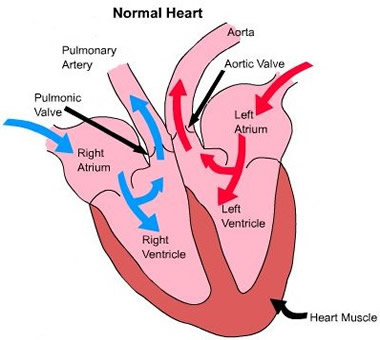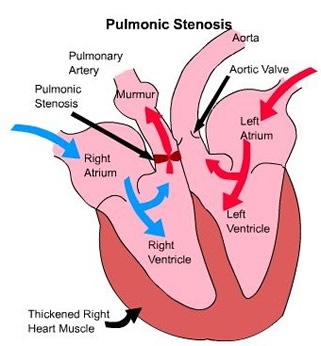
Virginia Luis Fuentes, Mike WS Martin and Peter Darke as appeared in the British Boxer Club Newsletter Winter 1990 pp12 - 14
British Boxer Club Newsletter
HEART MURMURS IN BOXERS
Virginaia Luis Fuentes, MA, VetMB, CertVR, CertSAC, MRCVS. Lecturer in cardiopulmonary medicine. Mike W.S.Martin, MVB, CertSAC, MRCVS. Resident in Cardiology. Peter G.G.Darke, BVSc, PhD, DVR, DVC, MRCVS. Senior lecturer in cardiopulmonary medicine. Department of Veterinary Clinical Studies, Royal (Dick) School of Veterinary Studies, Summerhall, EDINBURGH EH9 IQH. With summary and recommendations by Bruce Cattanach
Introduction
The British Boxer Club invited us to listen to Boxers’ hearts at their annual breed Championship show at Towcester on 28th July 1990. We were invited because of the Club’s increased awareness of heart disease in their breed. Our aim was to detect signs of heart disease by listening for murmurs and irregular heart rhythms. There have been reports that aortic stenosis and pulmonic stenosis are common congenital heart defects in Boxers. Both of these conditions will produce heart murmurs that can be heard by listening with a stethoscope.
At the show
The heat of the day caused many of the dogs to pant which gave difficulties in listening to the heart because of the increased breathing noises. Of 314 dogs entered in the show, 94 dogs were presented for examination. In addition 18 dogs which had not been entered in the show were presented. A total of 112 dogs were therefore examined. 26 dogs (23%) had murmurs. These murmurs were graded for loudness on a scale of 1 to 5, with 5 being very loud and 1 being very quiet.
Results
| Grade of murmur | Number of Dogs | Percentage of Dogs Affected |
| Grade 3 | 3 | 2.7% |
| Grade 2 | 8 | 7.1% |
| Grade 1 | 15 | 13.4% |
| No Murmur | 86 | 77.0% |
2 dogs had abnormal heart rhythms. 6 dogs had a history of collapsing or fainting
Discussion
A heart murmur is the sound produced when blood flow through the heart becomes turbulent. Turbulence can be produced by a narrowed valve (stenosis), a leaky valve, a “hole in the heart”, or very fast flow through a normal heart (a “flow murmur”). The source of the turbulence can be suspected from the site at which the murmur is loudest, and/or by the characteristic sound of a murmur. It can be difficult however, to distinguish the murmur of a narrowed aortic valve (aortic stenosis) from the murmur produced by a narrowed pulmonic valve (pulmonic stenosis), as these valves are situated very close together. Further more the murmur of aortic stenosis and the murmur produced by fast flow through a normal aortic valve (a “flow murmur”) may sound very similar.
All of the murmurs heard at the show were located in the area of the aortic/pulmonic valves. The louder murmurs (grades 2 and 3) are more likely to represent aortic or pulmonic stenosis, whereas the grade 1 murmurs could indicate mild stenosis or a normal flow murmur.
What is aortic stenosis?
Aortic stenosis is a congenital narrowing at the entrance of the aorta, which supplies blood to the body. It usually takes the form of a fibrous ring below the valve (sub-aortic stenosis).
Is it hereditary? It has not yet been determined if sub aortic stenosis is hereditary in Boxers in the UK. Breeding studies in the Newfoundland dog in the USA have shown it to be hereditary in this breed and it has been described as an inherited, autosomal dominant trait with variable penetrance.
How does aortic stenosis affect the heart?
The left ventricle has to pump with greater force to push blood past the narrowed valve. This results in thickening of the heart muscle wall; it enlarges just like any other muscle, because it is working harder. As a result of muscle thickening, the narrowing is made worse. Blood supply to the heart muscle itself is restricted, so that the heart muscle is working harder but with a reduced blood supply.
How does aortic stenosis affect the dog?
In mild cases the dog may show no sign of problems, and live a normal lifespan. In severe cases the dog may frequently collapse with exercise or excitement, or even die suddenly. Collapse or fainting occurs when the blood supply to the brain is inadequate. In aortic stenosis the heart may already be unable to meet the demands for an increased supply of blood to the body during exercise or excitement In addition, deficiency in the blood supply to the heart muscle itself may lead to abnormal heart rhythms, causing weakness or sudden death. Occasionally dogs develop congestive heart “failure”, in which fluid accumulation in the lungs causes breathlessness or coughing.
What is Pulmonic stenosis?
Pulmonic stenosis is a congenital narrowing at the valve of the pulmonary artery, which supplies blood to the lungs.
Is it hereditary?
It is not known if pulmonic stenosis is hereditary in the Boxer, but it has been shown to be hereditary in some breeds.
How does pulmonic stenosis affect the heart?
The effects of pulmonic stenosis are similar to aortic stenosis, but affect the right the side of the heart instead of the left.
How does pulmonic stenosis affect the dog?
Again, in mild cases the dog may be asymptomatic, but in severe cases dogs may collapse. Sometimes dogs develop failure of the right side of the heart, which results in fluid accumulation in the abdomen or chest.
How can aortic stenosis or pulmonic stenosis be diagnosed?
Most affected dogs will have an obvious heart murmur, although the murmur may only be heard over a small area or be muffled, especially in a fidgety dog An ECG (electrocardiogram) may help in diagnosis; this service is becoming more readily available from veterinary surgeons m practice. X-rays of the heart may be normal in aortic stenosis, but can be helpful in pulmonic stenosis and other heart conditions. “Ultrasound scans” (echocardiography) of the heart may show the stenosis or thickening of the heart muscle in severe cases, but may fail to detect milder cases. The most reliable method of diagnosing congenital heart defects is Doppler echocardiography, which can show blood turbulence at the source of a murmur and with which measurement of the speed of blood flow indicates the severity of the lesion. This is only available currently at some of the Veterinary Schools. Congenital heart defects can also be diagnosed by careful postmortem examination by an experienced pathologist.
Can aortic stenosis or pulmonic stenosis be treated?
Pulmonic stenosis can be treated in some cases, either surgically or by balloon catheters; these techniques are only available at some of the Veterinary Schools. When heart failure has developed however successful correction is less likely and surgery carries a greater risk. At present there is no reliable method of correcting aortic stenosis. Drugs however, may be of benefit in both conditions.
Summary and Recommendations by Bruce Cattanach
From our survey at the show, it appears that murmurs may be common amongst Boxers, but greater numbers of dogs need to be examined. It is also important that the exact source of a murmur is determined in each case by detailed investigation. It is only when an accurate diagnosis has been established that the tine incidence of aortic stenosis arid pulmonic stenosis in Boxers can be determined, and whether or not they are hereditary. This will require the cooperation of breeders, clubs and veterinary surgeons.
The report on the heart survey conducted at the British Boxer Clubs’ championship show this summer indicates that heart murmurs are common in the breed. This has been further established in a follow-up survey at a recent Scottish Boxer Club open show. There, out of a total of 31 dogs examined, 16 (50%) were found to have murmurs. Together with the23% (26 out of 112) identified at the British, a disturbing situation is indicated. However, these figures may somewhat exaggerate the magnitude of the problem. A proportion of dogs identified with murmurs do not in fact have heart abnormalities; the sounds heard reflect only the echoing effect of blood moving rapidly through the heart These are described as flow murmurs and appear to be of little significance From the veterinary report it is likely that flow murmurs will fall into the low grades of murmurs described into the report. If true. this would leave perhaps less than 3% of dogs with murmurs that could reflect aortic or pulmonarv stenosis but even if the frequency were as low as this it would still be worrying for the breed.
Several actions are warranted. I have already recommended to Breed Council that further surveys in other regions of the country should be carried out. This could give a better idea of the magnitude of the problem. Furthemore, for the same reason it is imperative that there should be follow-up studies on dogs identified with murmurs to determine which in fact are normal, having flow murmurs only, and how many have genuine heart abnormalities. Beyond this, while it may be too early to set up a control scheme as done for PA - further research is necessary and a panel of heart experts throughout the country might be needed - I suggest the present situation already warrants some action. Discretion in breeding now might avoid a need for complex control schemes later
I suggest that it would be worthwhile for all breeders to initiate the following procedures:
1. Have all breeding stock and youngsters heart-checked locally and have follow-up specialist examinations on those with murmurs.
2. Discard for breeding purposes all stock which are not normal.
3. Use only those stud dogs that have been heart-tested and proven normal. This should include imported dogs as aortic stenosis is known to be a risk in boxers in both the US and elsewhere in Europe. (Breed Council could draw up a list of dogs with appropriate health certificates).
4 Stud dog owners could accept only those bitches with such health certificates.
In addition to the above, I would strongly urge that tattoo-identification be used to help legitimise such selective procedures. I am convinced that dog identification will become essential in the future for all sorts of reasons; it would add prestige to the start now.



